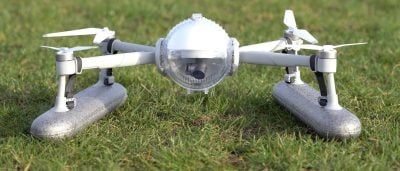PowerVision PowerEgg X review
-
-
Written by Adam Juniper
Verdict
The PowerEgg X is worthy of attention. In many ways it’s the Sony Sports Walkman of the drone market; it’s eye-catching, great for the active lifestyle, undoubtedly a quality product, but the hi-fi geek inside many would look longingly at it then stay indoors with one of the brand’s less imaginative models muttering something about audio fidelity.
Because it’s such an unusual product – making a different set of compromises – it’s harder to decide whether it’s ideal for your purposes. Personally I have little interest in the AI camera aspect as, even though I am finally, over a decade late, making a faltering start at YouTubing, I’m content to use a Sony A7iii locked off. I also have an old DJI Osmo Mobile which fulfils my portable gimbal needs (and anyone can have the new one for around $120/£100 – about the same as a drone battery). So, to my mind, it’d be just as logical to acquire a hand-gimbal like that (depending on the quality of your phone’s camera) and a drone at the same time – price-wise the obvious alternatives are the Mavic Air and the Parrot Anafi.
The Mavic Air has a very disappointing flight time, can’t produce 60fps at 4K, and is no match for the PowerEgg X in a strong wind, but it is more compact and there is much to be said for DJI’s image processing algorithms which seem to get a little more from its 12-megapixel camera. It also has front-facing collision sensors and a range of QuickShots. Then again there is no waterproof option.
The Anafi, on the other hand, has a 21-megapixel camera and an unusual gimbal allowing it to turn up as well as down. It has a similar flight time (25 minutes) to the PowerEgg X, is available for more enticing prices and in a range of interesting combinations. Recent updates have added FPV flying which sounds like fun (OK, is fun) but also has serious photographic utility. Alternatively, there is a ‘Work’ edition with 3D mapping software included.
Given these alternatives, I can’t help but feel that the PowerEgg X is only clearly the better choice if action, sport, and especially watersport are important to you thanks to its high frame rate option. The Egg is also better than both in wind, and has the longest flight time, but the still image quality is marginally behind both – an issue especially apparent in poor light. Also the Egg doesn’t seem to have the means to add an ND filter, unlike the Anafi, at least not yet.
Another case for the PowerEgg X is for folks already happy with one aircraft but are looking to expand their professional repertoire. Working in water (and rain) is easily the most significant potential expansion of possibilities and, at this price point, there is nothing else available. (Even the very, very much more expensive DJI Matrice have had problems with their waterproofing).
In both scenarios, it’s the Wizard edition that puts the PowerEgg X comfortably ahead, so it’s the more expensive option. It does what it says on the tin beautiful packaging there and – while there are issues with the waterproofing in certain lighting – it handles the job well. Even with this kit, the ‘copter is also very competitively priced.
Summary
The PowerEgg X is a drone, an A.I.-assisted gimbal-stabilised camcorder and Camera, is so unlike any other drone it’s difficult to know where to assess it from. There are aspects which compete with the DJI Phantom, and others with a GoPro or the DJI Osmo series. The PowerEgg X, as its name suggests, is an unusual shape, and – assuming you buy the more expensive ‘Wizard’ edition – it can even fly in the rain and land on a pond. Taken against the mainstream competition, even the standard ‘Explorer’ edition is well-designed, well built, nicely packaged and competitively priced. It’s not the best camera out there, but even though the imaging sensor could be bigger, it does pack 4K at 60fps (double the Mavic Air or Mavic 2’s 30fps), and a set of other slow-mo options making it almost unbeatable for action fans. DJI operators would need a Phantom 4 Pro V2 – costing significantly more – or an Inspire 2 series machine to get 4K at 60fps. Better still there has been no sliming-down of creative features – RAW, bracketing, manual and everything else is all there, as well as in-app downloading and editing tools. Most niggles seem likely to be resolved in software, and PowerVision are already off to a good start on that score – no vapourware worries here. The unusual form factor, though, means that you need to think hard about its benefits to you.




